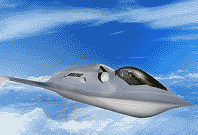|
Although there are significant design trade-offs between stealth and
aircraft flight performance, it's obvious that being able to enter
enemy territory without early detection offers great tactical
advantages—so much so that stealth was one of the key
requirements of the Joint Strike Fighter (JSF), America's
next-generation fighter plane. Both Lockheed Martin and Boeing
designed their X-Planes to be much stealthier than the aircraft the
JSF will replace. Although Lockheed Martin's X-35 ultimately won out
over Boeing's X-32, Boeing unveiled its own ultra-secret and
ultra-stealthy Bird of Prey prototype fighter to much fanfare.
Achieving stealth means minimizing all the ways that an enemy can
detect a plane, whether by sight, noise, heat, or radar waves.
Avoiding radar detection in particular demands a great deal of
sophisticated engineering and manufacturing savvy, and the results
sometimes seem just short of miraculous: In the late 1980s in an
experimental stealth project, a plane sitting on the tarmac prior to
take-off was completely invisible to personnel looking through a
radarscope. The only reason they detected the plane was because a
bird had landed on top and appeared to be floating in midair.
The bottom line for stealth—as it is for all good combat
aircraft—is that designers must assess all mission
requirements and make intelligent design tradeoffs to achieve the
best balance of overall combat capabilities. Attempting to be
totally invisible to all conceivable enemy threats in all potential
scenarios is impossible and can lead to disastrous compromises that
may result in ineffective combat performance. Here, take a closer
look at Boeing's Bird of Prey and learn some of the ways that
aircraft designers can achieve stealth.
|

|
|
Flash is a plug-in that allows for increased
interactivity. If you can see the animated boxes at
left, the plugin is already installed. If you do not see
the boxes, you can
install the Flash plugin.
|
|
|

|
Aircraft Design: A Conceptual Approach, by Daniel
P. Raymer. Reston, VA: American Institute of Aeronautics
and Astronautics, 1999.
Popular Science's First Look at Bird of Prey
http://www.popsci.com/popsci/
aviation/article/
0,12543,365576,00.html
Fifteen Minutes of Stealth
http://www.aoe.vt.edu/
aoe/faculty/
Mason_f/ConfigAeroStealth.pdf
Stealth Technology
http://allsands.com/Science/
stealthtechnolo_voz_gn.html
F22Fighter.com—the Site of the 21st Century
Fighter
http://www.f22fighter.com/
stealth.htm
|
|
Lauren Aguirre is executive editor of NOVA online.


|

